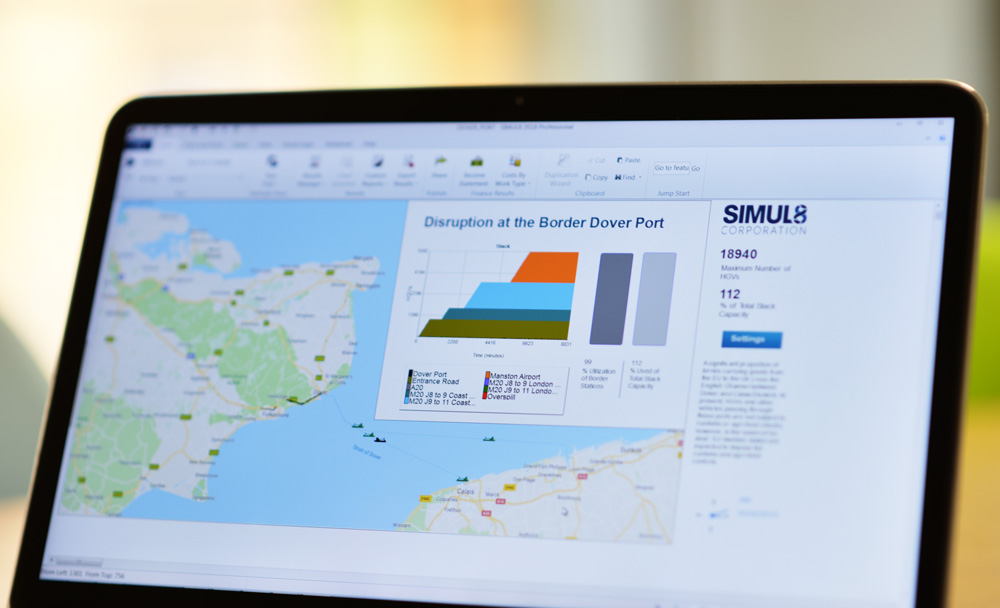With Brexit negotiations entering a critical phase, organizations across the UK and Europe are working hard on contingency plans for the different scenarios that could occur. A key aspect of these plans will be how the flow of goods will be impacted in the event of a no-deal exit.
The BBC reported on Dec 7 that “Dover and other Channel ports face disruption for up to six months if the UK leaves the EU without a deal”. This disruption could impact both exports and imports if additional time is needed to perform port custom checks in the event of a ‘no-deal’ exit on March 29 2019.
Using simulation to determine the impact on vehicle queues at Dover
Here at SIMUL8 Corporation we believe in an analytical approach to understanding these types of challenges, using powerful simulation software to test scenarios and identify the possible outcomes.
Using publicly available information and data, we have created a simulation that shows the level of queues that could be experienced at the port of Dover if freight vehicle border checks going to France are increased.

Why would queues occur?
In 2017 over 2.5 million freight vehicles passed through the port. This equates to over 3,500 per day or 148 per hour going in each direction. The majority of these vehicles carry goods from the EU to the UK cross the English Channel between Dover and Calais/Dunkirk. At present, these freight vehicles passing through these ports are not subject to customs or agri-food checks as the UK is part of the customs union. However, in the event of no-deal Brexit, EU member states are expected to impose full customs controls that would be carried out in the UK before vehicles leave the country.
Currently, a small percentage, around 1%, of freight vehicle traffic entering and leaving the port of Dover is non-EU and subject to full customs checks. The Port of Dover says EU lorries are currently processed in around two minutes, whereas it takes 20 minutes or more to clear non-EU vehicles. In a no-deal Brexit, all freight traffic would be subject to longer checks and as a result, delays are likely to happen.
As a result, we wanted to use simulation to understand what the result of these increased checks might be.
What’s the possible impact?
The UK government have a procedure in place in the event of disruption to Dover traffic flow, named “Operation Stack”. In the first instance, there is space at the port of Dover for up to 1,500 freight vehicles. After this reaches capacity, vehicles begin queuing on the surrounding roads and motorways, including the A20 and M20 coast bound. Once this capacity is used up, vehicles may be diverted to the nearby unused Manston Airport, adding further capacity for around 4,000 vehicles. As a final resort, vehicles will then be queued along the M20 London bound, with capacity for 4,100 vehicles.
With many freight vehicles carrying perishable items like fruits, vegetables, meat, fish and medicine, there is also a risk of substantial waste and cost implications for businesses if goods are trapped in queues beyond their shelf life. The problem could become further aggravated as many of the freight vehicles that take goods out of the UK also bring goods back when they return. If vehicles become stuck on one side, the flow of goods back to the other side will be impacted too.
Ensuring a smooth flow of freight vehicles will be vital to avoid waste, shortages of goods and roads being backed up with traffic.
Our simulation results
When we ran the simulation over a period of three weeks from March 29, it showed that under current check-in conditions with three check-in desks and taking two minutes per freight vehicle, the backup of the queue was minimal. It reached a manageable maximum queue of 1071 vehicles.
However, when we increased the check-in time to four minutes, the maximum freight vehicles in the queue drastically jumped to 52,396. By further increasing the check-in time to 20 minutes, the queue reached a huge 70,594 vehicles. This would far exceed the maximum number of freight vehicles that can be queued at any given time, leading to huge disruption at the port and on the surrounding roads.
Prepare for any scenario with SIMUL8 simulation software
Until a final agreement or no-deal is agreed between the European Union and the UK, nobody can say for certain what the end outcome will be.
In challenging circumstances like these, simulation offers organizations a powerful, evidence-based approach to decision-making. SIMUL8 Corporation’s flagship simulation software is used by leading Fortune 500 companies to test internal and external changes to their business processes. The insight from SIMUL8 enables them to prepare for different scenarios and make stronger, confident decisions about the future of their businesses.